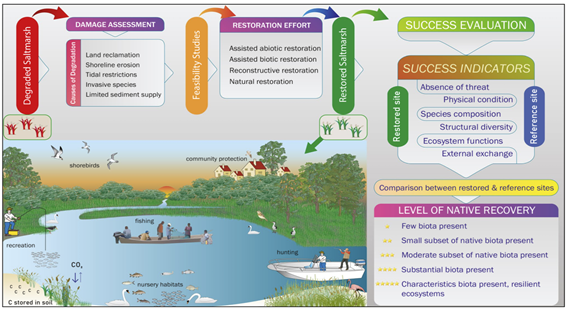January 6, 2022 | Environmental Science and Pollution Research | Source |
Introduction: Salt marshes are vital coastal ecosystems that support biodiversity, store carbon and protect shorelines. Yet, they face mounting threats from land reclamation, sediment depletion, eutrophication, and sea-level rise—driving a surge in global restoration initiatives. Addressing the lack of a comprehensive synthesis on restoration strategies and evaluation metrics, researchers from Italy, Spain, Bangladesh, and Malaysia analyzed 78 peer-reviewed studies, highlighting a shift toward functional indicators alongside traditional structural metrics.
Key findings: Among the 78 reviewed studies, 67% were from the USA, with post-2002 publications indicating increased interest in salt marsh restoration. Most projects used assisted abiotic techniques, such as tidal flow restoration, dike breaching, and sediment amendment. The study identified 214 success indicators, primarily related to ecosystem functions (33.2%) and structural diversity (32.7%), with carbon dynamics and vegetation traits being the most common. Threat reduction indicators, like invasive species control, were underrepresented. Recent studies highlight microbial communities and carbon sequestration as emerging priorities. Recovery timelines varied: hydrology and fish use recovered quickly; vegetation took years; macrobenthic density 5–25 years; and soil carbon and nitrogen 15–30 years. Peat formation could take up to a century. The authors proposed a conceptual model incorporating site assessment, tailored interventions, and a five-star rating system to guide and communicate restoration success, urging broader use of underutilized indicators and standardized evaluation criteria.

Figure|Conceptual model of suggested salt marsh restoration approach and success evaluation (Some symbols used in this figure are courtesy of the Integration and Application Network, University of Maryland Center for Environmental Science—ian.umces.edu/symbols/)



